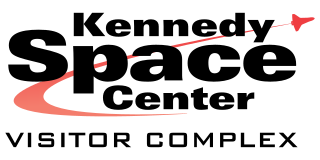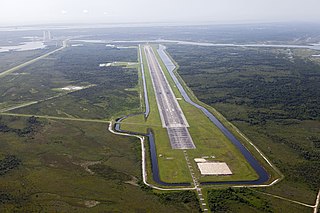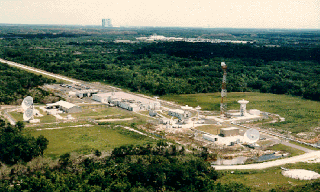
The John F. Kennedy Space Center, located on Merritt Island, Florida, is one of the National Aeronautics and Space Administration's (NASA) ten field centers. Since December 1968, KSC has been NASA's primary launch center of human spaceflight. Launch operations for the Apollo, Skylab and Space Shuttle programs were carried out from Kennedy Space Center Launch Complex 39 and managed by KSC. Located on the east coast of Florida, KSC is adjacent to Cape Canaveral Space Force Station (CCSFS). The management of the two entities work very closely together, share resources and operate facilities on each other's property.

Space Shuttle Challenger was the second orbiter of NASA's Space Shuttle program to be put into service, after Columbia. Challenger was built by Rockwell International's Space Transportation Systems Division, in Downey, California. Its maiden flight, STS-6, began on April 4, 1983. The orbiter was launched and landed nine times before disintegrating 73 seconds into its tenth mission, STS-51-L, on January 28, 1986, resulting in the deaths of all seven crew members including a civilian school teacher.

Space Shuttle Discovery is one of the orbiters from NASA's Space Shuttle program and the third of five fully operational orbiters to be built. Its first mission, STS-41-D, flew from August 30 to September 5, 1984. Over 27 years of service it launched and landed 39 times, aggregating more spaceflights than any other spacecraft to date. The Space Shuttle launch vehicle has three main components: the Space Shuttle orbiter, a single-use central fuel tank, and two reusable solid rocket boosters. Nearly 25,000 heat-resistant tiles cover the orbiter to protect it from high temperatures on re-entry.

Cape Canaveral Space Force Station (CCSFS) is an installation of the United States Space Force's 45th Space Wing, located on Cape Canaveral in Brevard County, Florida.

The Space Coast is a region in the U.S. state of Florida around the Kennedy Space Center (KSC) and Cape Canaveral Air Force Station. All of NASA-launched crewed spaceflights have departed from either KSC or Cape Canaveral. The Air Force Station has also launched unmanned military and civilian rockets. Cities in the area include Titusville, Cocoa, Rockledge, Cape Canaveral, Merritt Island (unincorporated), Cocoa Beach, Melbourne, Indialantic, Palm Bay, and Viera (unincorporated). Most of the area lies within Brevard County. It is bounded on the south by the Treasure Coast, on the west and north by Central Florida, and on the east by the Atlantic Ocean.

Launch Complex 39 (LC-39) is a rocket launch site at the John F. Kennedy Space Center on Merritt Island in Florida, United States. The site and its collection of facilities were originally built as the Apollo program's "Moonport" and later modified for the Space Shuttle program.
A hackathon is a design sprint-like event; often, in which computer programmers and others involved in software development, including graphic designers, interface designers, project managers, domain experts, and others collaborate intensively on software projects.

The Kennedy Space Center Visitor Complex is the visitor center at NASA's Kennedy Space Center in Florida. It features exhibits and displays, historic spacecraft and memorabilia, shows, two IMAX theaters, and a range of bus tours of the spaceport. The "Space Shuttle Atlantis" exhibit contains the Atlantis orbiter and the Shuttle Launch Experience, a simulated ride into space. The center also provides astronaut training experiences, including a multi-axial chair and Mars Base simulator. The visitor complex also has daily presentations from a veteran NASA astronaut. A bus tour, included with admission, encompasses the separate Apollo/Saturn V Center. There were 1.7 million visitors to the visitor complex in 2016.

The Shuttle Landing Facility (SLF) is an airport located on Merritt Island in Brevard County, Florida, United States. It is a part of the Kennedy Space Center and was used by Space Shuttle for landing until July 2011. It was also used for takeoffs and landings for NASA training jets such as the Shuttle Carrier Aircraft and for civilian aircraft.

The Neil Armstrong Operations and Checkout Building (O&C) is a historic building on Merritt Island, Florida, United States. The five-story structure is in the Industrial Area of NASA's Kennedy Space Center. Its facilities include the crew quarter dormitories for astronauts, and suit-up preparations prior to their flights. The other facility is a large spacecraft workshop used for manufacturing and checking activities on crewed spacecraft. On January 21, 2000, it was added to the U.S. National Register of Historic Places.

Launch Complex 39B (LC-39B) is the second of Launch Complex 39's two launch pads, located at NASA's Kennedy Space Center in Merritt Island, Florida. The pad, along with Launch Complex 39A, were first designed for the Saturn V launch vehicle, which at the time was the United States' most powerful rocket. Typically used to launch NASA's crewed spaceflight missions since the late 1960s, the pad is currently being reconfigured for use by the agency's Space Launch System rocket, a Shuttle-derived launch vehicle which will be used in the Artemis program and subsequent Moon to Mars campaigns. The pad had also been leased for use by NASA to aerospace company Northrop Grumman, for use as a launch site for their Shuttle-derived OmegA launch vehicle, for National Security Space Launch flights and commercial launches, before the OmegA was cancelled.

The Merritt Island Spaceflight Tracking and Data Network station, known in NASA parlance as MILA, was a radio communications and spacecraft tracking complex located on 61 acres (0.25 km2) at the Kennedy Space Center (KSC) in Florida. The name MILA was an acronym for the "Merritt Island Launch Annex" to Cape Canaveral Air Force Station, which was how the site was referred to when spacecraft launches were primarily originating from the adjacent military installation. MILA's arrays of antennas provided various communications and data services between spacecraft and NASA centers, as well as tracked and ranged moving spacecraft. In its final years, it served as the primary voice and data link during the first 7½ minutes of Space Shuttle launches, and the final 13 minutes of shuttle landings at KSC. Though it occupied land at KSC, MILA was operated and managed by the Goddard Space Flight Center.

The NASA Railroad is a Class III industrial short-line railroad at the Kennedy Space Center in Cape Canaveral, Florida. The railroad consists of 38 miles (61 km) of track connecting the mainline of the Florida East Coast Railway and trackage at the Cape Canaveral Air Force Station.

45th Weather Squadron, 45th Operations Group, 45th Space Wing, at Patrick Space Force Base, Florida performs weather assessments for air and space operations; specifically, weather observations, forecasts, advisories, and warnings. It specialized in the weather assessments for the Space Shuttle launches at Kennedy Space Center (KSC) and Cape Canaveral Space Force Station.

Launch Services Program (LSP) is responsible for NASA oversight of launch operations and countdown management, providing added quality and mission assurance in lieu of the requirement for the launch service provider to obtain a commercial launch license. It operates under the Human Exploration and Operations (HEO) Mission Directorate of NASA.

The Mercury Control Center provided control and coordination of all activities associated with the NASA's Project Mercury flight operation as well as the first Project Gemini flight, Gemini 3. It was located on the Cape Canaveral Air Force Station near Launch Complex 14.
The Cyprus Space Exploration Organisation (CSEO) is a non-governmental, nonprofit organisation, based in Cyprus, with a global scope of service and activities. Its main functions are outreach, education, research, development, advocacy, and international cooperation in the field of space exploration, astronautics and astronomy. The organisation promotes and facilitates international scientific collaboration in space exploration, and fosters domestically collaboration with other space-faring nations in science, space and planetary missions. It was founded in 2012 and has over 800 registered researchers, members and volunteers and over 100,000+ followers on social media. Its President is George A Danos, and the Chair of CSEO's International Council is Prof Marcello Coradini, ESA's Head of Solar System and Robotic Exploration (1987-2010).

SpaceX Crew-1 is the first operational crewed flight of a Crew Dragon spacecraft. It is also the first crewed night launch by the United States since that of STS-130 in February 2010. The Crew Dragon spacecraft Resilience launched on 16 November 2020 at 00:27:17 UTC on a Falcon 9 from the Kennedy Space Center, LC-39A, carrying NASA astronauts Michael Hopkins, Victor Glover and Shannon Walker along with JAXA astronaut Soichi Noguchi, all members of the Expedition 64 crew. The mission is the second overall crewed orbital flight of the Crew Dragon.

Crew Dragon Resilience is a Crew Dragon spacecraft manufactured by SpaceX and built under NASA's Commercial Crew Program (CCP). It is currently docked on orbit to the International Space Station (ISS) on the Crew-1 mission after launch at 00:27 UTC on November 16, 2020 delivering the four additional members of Expedition 64 to the three already on station. With crew prompting, Resilience docked autonomously to the station at 04:01 UTC on Day 2 of the mission marking the first crewed operational flight of a Crew Dragon craft and the Commercial Crew Program.


















